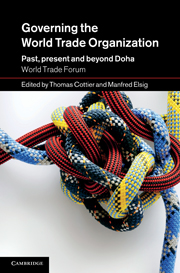Book contents
- Frontmatter
- Contents
- List of figures
- List of tables
- Notes on Contributors
- Preface
- List of abbreviations
- 1 Introduction
- PART I Setting the stage
- PART II Boundaries
- 4 Internal measures in the multilateral trading system: where are the borders of the WTO agenda?
- 5 Legitimising global economic governance through transnational parliamentarisation: how far have we come? How much further must we go?
- PART III Emerging and established powers
- PART IV Weaker actors
- PART V The consensus principle
- PART VI Quo vadis?
- Index
- References
4 - Internal measures in the multilateral trading system: where are the borders of the WTO agenda?
Published online by Cambridge University Press: 07 September 2011
- Frontmatter
- Contents
- List of figures
- List of tables
- Notes on Contributors
- Preface
- List of abbreviations
- 1 Introduction
- PART I Setting the stage
- PART II Boundaries
- 4 Internal measures in the multilateral trading system: where are the borders of the WTO agenda?
- 5 Legitimising global economic governance through transnational parliamentarisation: how far have we come? How much further must we go?
- PART III Emerging and established powers
- PART IV Weaker actors
- PART V The consensus principle
- PART VI Quo vadis?
- Index
- References
Summary
Introduction
A core issue for the multilateral trading system over the years has been the reach of its competence. Of all the sources of tension that have confronted the General Agreement on Tariffs and Trade/World Trade Organization (GATT/WTO) system over the years, this is probably the greatest. Effective international cooperation requires a shared view on the content and purpose of the trading system. Yet agreement has often proved elusive and negotiated outcomes have occasionally been challenged by governments even though they have subscribed to them. The debate in the late 1970s and 1980s about whether trade in services had a place in GATT, for example, has been followed by similar discussions on intellectual property rights (IPRs), labour rights, the environment, investment and competition. Differing views on these matters have often influenced the pace of progress in rounds of multilateral trade negotiations.
At first sight, the WTO's mandate seems to be well defined: it is an organisation that deals with the rules of trade between its members. Why is it then that WTO Agreements deal with internal measures and why has the question of how the WTO deals with internal measures become so contentious? The most straightforward answer to the first question is probably that most internal measures have an effect on trade flows. As a result, a body that provides rules on trade flows can be expected to have to take a stance with respect to internal measures.
- Type
- Chapter
- Information
- Governing the World Trade OrganizationPast, Present and Beyond Doha, pp. 49 - 81Publisher: Cambridge University PressPrint publication year: 2011
References
- 3
- Cited by



